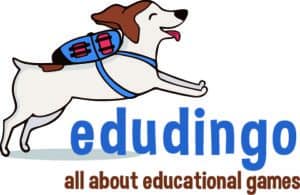This post contains affiliate links.
Rhyme games are great for phonemic awareness as children always enjoy rhymes. My daughter and most children are real fans of dice games, so I decided to do this comparison of existing rhyme dice games.
So what are the available Rhyme Dice Games?
- Roll a Rhyme has dice featuring graphics of objects and characters from nursery rhyme songs and helps to create your own songs.
- There are also 4 Phonics Dice Sets with dice that feature word endings or sounds such as Phonics Cubes or Roll & Read.
- Rods phonics sets such as Word for Word are also an interesting alternative because rods can be stuck together to form words
Rhyme Dice & Rods Games Comparison Table
| Game | Type | Age | Players | For | Price | Rating |
|---|---|---|---|---|---|---|
| Roll a Rhyme | Dice | 3-8 | 2 | Home | $ | ★★★☆☆ |
| Phonics Cubes | Dice | 3‑7 | 2‑8 | Home, School | $$$ | ★★★★★ |
| Reading Dice | Dice | 3‑7 | 2‑12 | Home, School | $$ | ★★★★☆ |
| Word Families | Dice | 5‑7 | 1‑6 | Sschool | $$ | ★★★★☆ |
| Roll & Read | Dice | 3‑6 | 1‑5 | Home, School | $$$ | ★★★★★ |
| Word for Word | Rods | 3‑7 | 2‑4 | Home, School | $$$ | ★★★★★ |
Rhyme Dice Games
There are few rhyme dice games, but they can be a nice alternative to other types of rhyme games such as puzzles, card games or board games. Many kids love to manipulate dice, and dice themselves are the perfect expression of randomness.
Roll A Rhyme (Junior Learning)
★★★☆☆
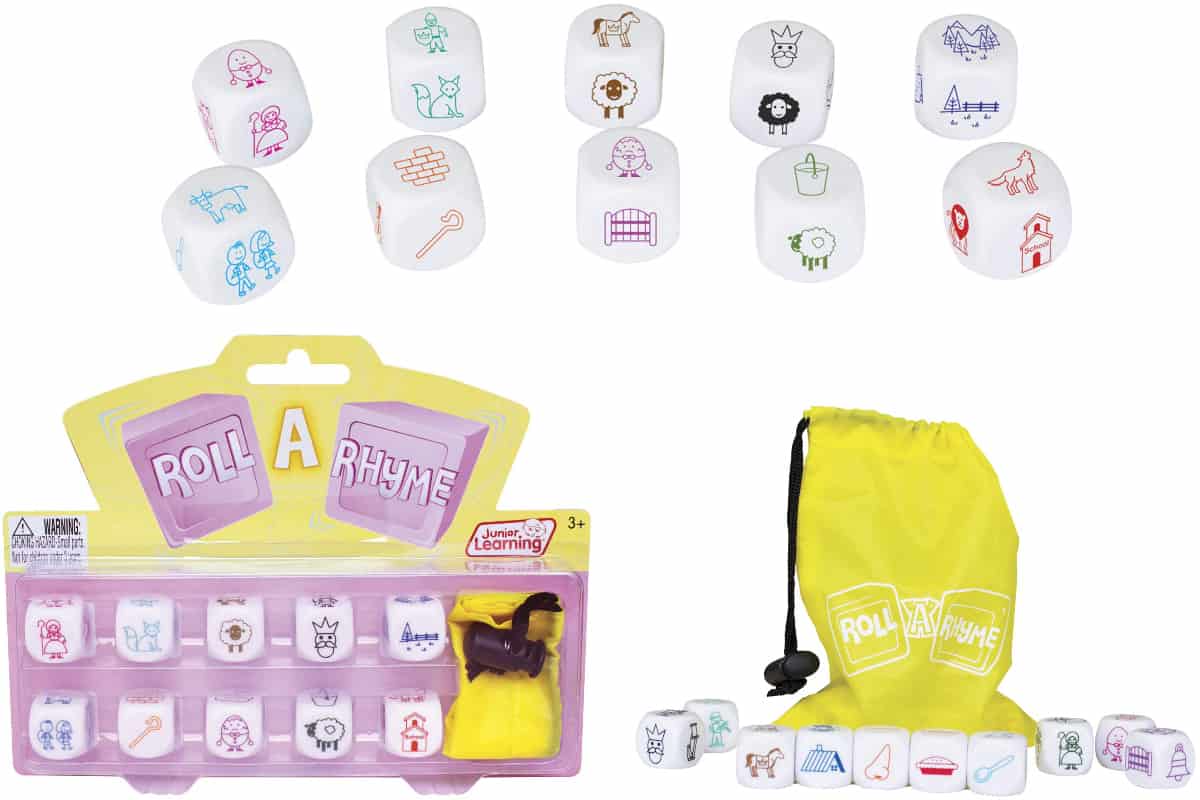
For Families | Age 3-8 | 2 players
Roll a Rhyme contains 10 dice and a cool carry sack. Each dice has a simple illustration on each face. The idea is to roll the dice, select the dice you want to keep and create a rhyme using those words. As always with dice, the nice thing is to quickly draw random combinations.
contains 10 dice and a cool carry sack. Each dice has a simple illustration on each face. The idea is to roll the dice, select the dice you want to keep and create a rhyme using those words. As always with dice, the nice thing is to quickly draw random combinations.
As the dice are small you should be careful when using them with 3-year-old children who might swallow them. Of course, you also need some imagination to play “Roll A Rhyme”, as you are required to create a rhyme every time.
Phonics Cubes Class Set (Hand 2 Mind)
★★★★★
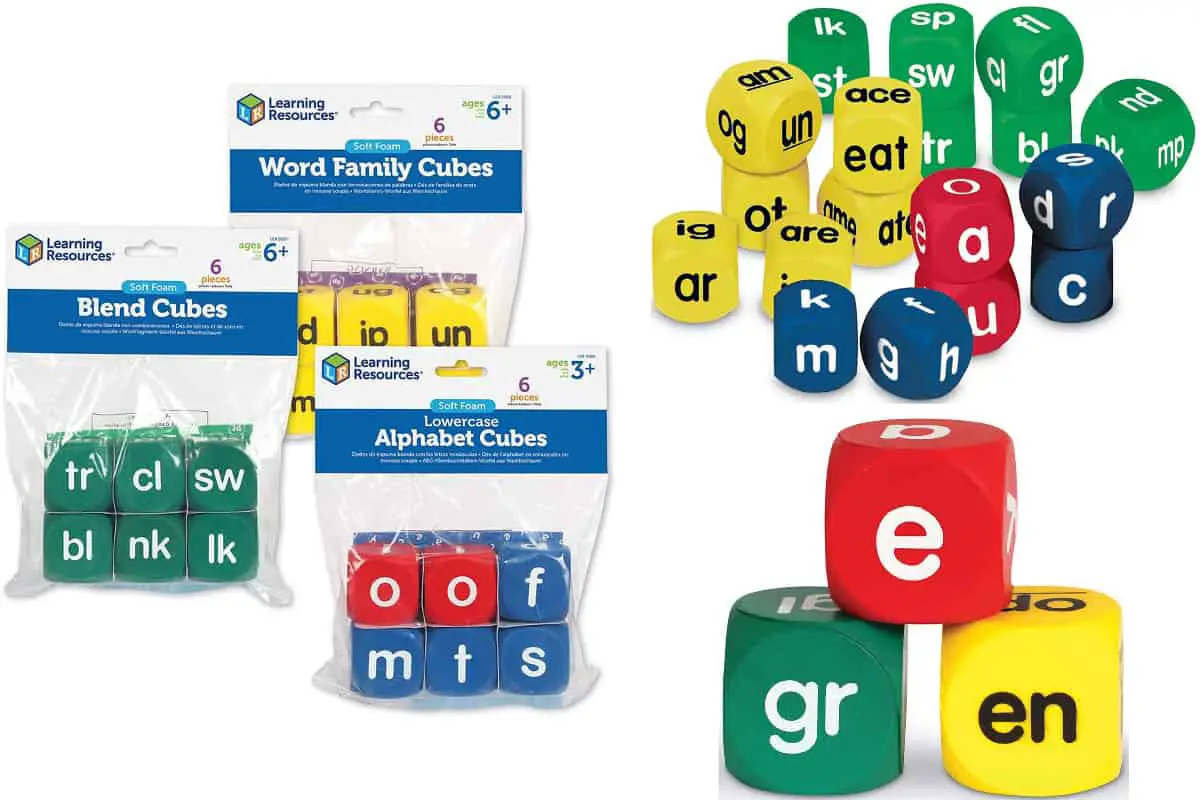
For Teachers and parents | Age 3-7 | 2-6 players
Phonics Cubes is a set of 18 foam cubes (larger than regular dice) divided as follows:
is a set of 18 foam cubes (larger than regular dice) divided as follows:
- Yellow word family cubes featuring 36 word families that you can use for rhyming games:
- 3 two-letter word family cubes featuring: ar, at, am, an, ad, ay, ag, ap, ig, ip, ug, ug, un, en, ed, ow, op, ot
- 3 three-letter word family cubes featuring: and, ace, ave, ame, ail, ake, ate, ack, ain, are, ink, ine, ick, ing, eat, ear, one, ore
- 6 Green two-letter blend (consonant cluster) cubes: 4 beginning blend cubes and 2 bending blend cubes featuring in total 9 blends: ft, lk, lt, mp, nd, nk, nt, sk, & st (unfortunately ch, sh, th and wh are lacking): you can also use them in your rhyming games
- 6 Alphabet cubes: 2 red cubes with vowels, and 4 blue cubes with consonants – they are useful for word building games
I highly recommend Phonics Cubes for teachers because of the many possible uses both in phonics & word building – and the game also makes real sense at home, even if the lack of rules will make it more difficult for a parent to make use of its possibilities.
Reading Dice (Fun Express)
★★★★☆
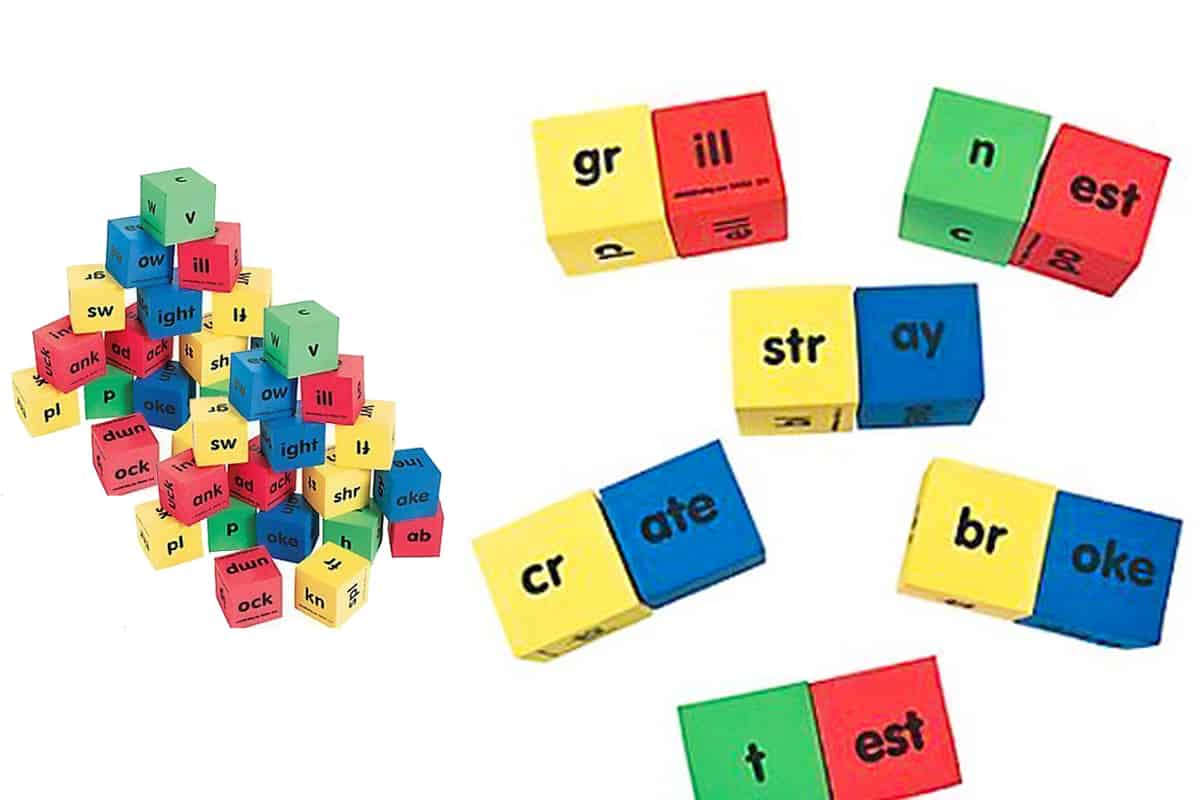
For Teachers and parents | Age 3-7 | 2-12 players
Reading Dice is a series of 17 reading foam dice, including beginning sounds and ending sounds (featuring 102 different sounds) – it is sold with two sets of identical dice, meaning you have 34 dice overall.
is a series of 17 reading foam dice, including beginning sounds and ending sounds (featuring 102 different sounds) – it is sold with two sets of identical dice, meaning you have 34 dice overall.
I recommend “Reading Dice”, which you can use in the same manner as “Phonics Cubes. It is more comprehensive (number of sounds covered).
Word Families Giant Activity Dice (Lakeshore)
★★★★☆
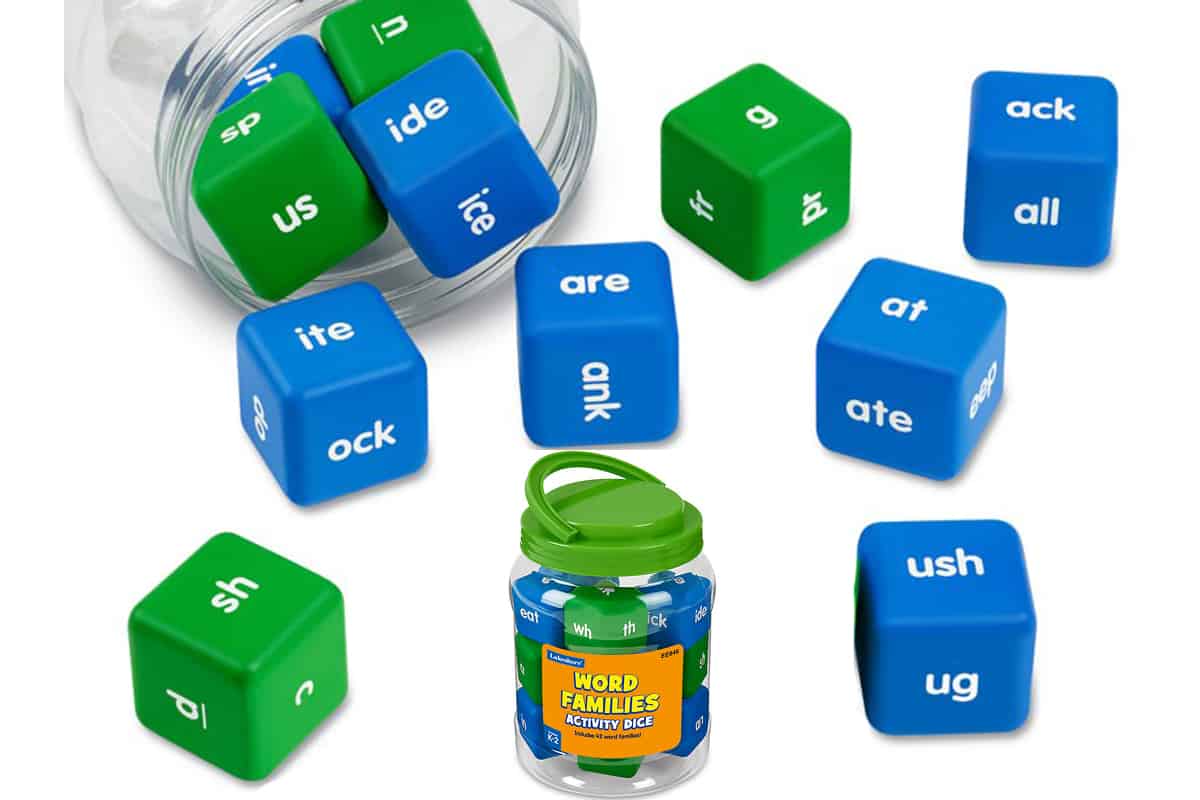
For Teachers | Age 5-7 | 1-6 players
Word Families is a plastic jar that includes 12 large dice and an activity guide. The size of the dice makes them easy to handle and use. Dice are made of durable foam offering quiet classroom time.
is a plastic jar that includes 12 large dice and an activity guide. The size of the dice makes them easy to handle and use. Dice are made of durable foam offering quiet classroom time.
The dice include 42 word families.
Children can roll the dice, figure a word and come up with as many rhyming words as he can. You can either make children compete over the number of words figured out, the number of rhyming words or both!
I recommend “Word Families” for autonomous learning or small groups.
Roll & Read Phonics Dice Set (PDX reading specialist)
★★★★★
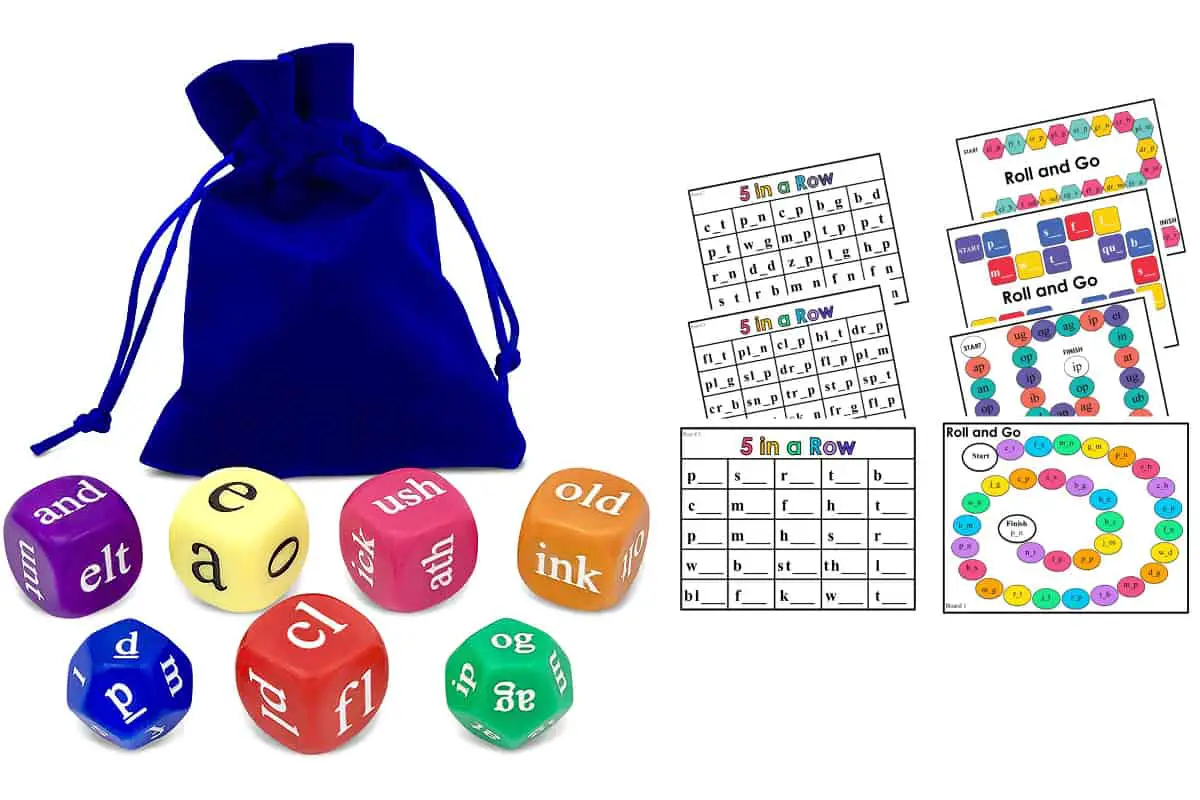
For Parents and teachers | Age 3-6 | 1-5 players
Roll & Read Phonics comes with 7 simple board games, 7 color-coded phonics dice (5 six-faced dice and two 12-faced dice) and an instruction sheet with multiple ways to use the game.
comes with 7 simple board games, 7 color-coded phonics dice (5 six-faced dice and two 12-faced dice) and an instruction sheet with multiple ways to use the game.
The letters on these dice are engraved (not printed like on foam dice), which means that they are less likely to fade over time.
I highly recommend Roll & Read Phonics because of the diverse games proposed (thanks to the dice + boards), and also because the dice are cute, especially because of the 12-faced dice that children really like.
because of the diverse games proposed (thanks to the dice + boards), and also because the dice are cute, especially because of the 12-faced dice that children really like.
Is a Rhyme Dice Game A Good Choice?
The first thing to do is to realize whether your child likes dice games in general. If he does, then he will probably like rhyme dice games too.
Also, consider that rhyme dice games are suitable for small groups. They can be helpful if you are a mother of more than one child and can be great for parent-child bonding time.
Not only are rhyme games great for phonemic awareness, but they can also be put to different uses. For example, you can ask players to make short funny songs or stories out of the rhyming words, for more creativity.
Teachers can use this idea to teach children to create meaningful sentences and boost their imagination.
Rhyme Rods Games
Word for Word Phonics (Learning Resources)
★★★★★
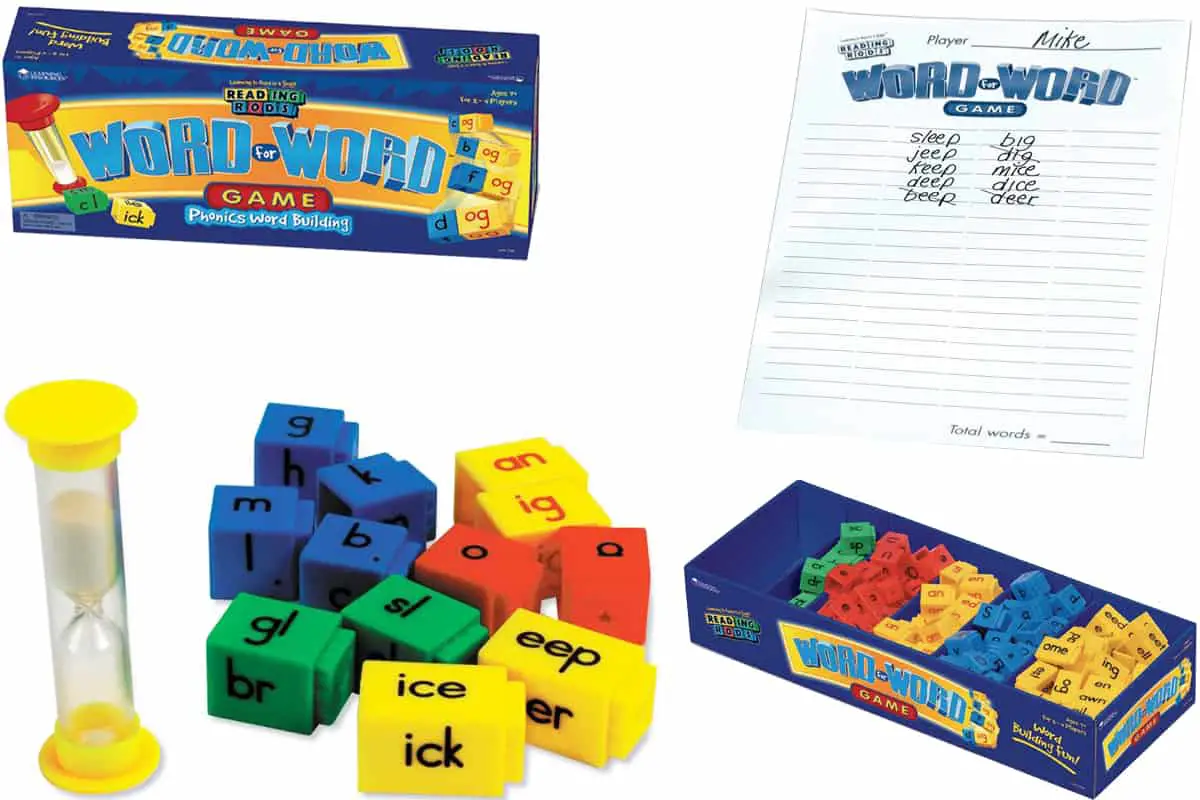
For Parents and teachers | 2-4 players | Age 3-8
Word for Word Phonics includes 112 color-coded rods, a 2-minute timer, 4 pencils, a score pad, and instructions.
includes 112 color-coded rods, a 2-minute timer, 4 pencils, a score pad, and instructions.
You can tweak the word building rules to create a rhyming game by using the yellow rods for the rhymes.
I highly recommend Word for Word because these rods are very versatile – and they have the advantage over dice that you can stick the pieces together to build words – in this case, build several words that rhyme and end with the same yellow piece. I recommend them for parents as well although this game is a bit expensive and essentially designed for schools.
Other Phonics Rods Sets You Can Use To Create Rhyming Games
Here are some other rods game you can easily tweak to create rhyming games:
- Unifix Letter Blends Cubes Set
 (DIDAX)
(DIDAX) - Unifix Reading Phonics Kit
 (DIDAX)
(DIDAX) - Word Building Cubes for Early Reading
 (hand2mind)
(hand2mind)
Other Types of Rhyme Games
If you are interested in more rhyme games, you might want to check my post “13 Rhyme Card, Puzzle & Domino Games for Primary & Preschool Children”. You may also want to check out 10 Rhyme Board Games and Toys for Preschoolers and Primary School  for more great learning game ideas to try.
for more great learning game ideas to try.
You may want to start with rhyme cards as they are the simplest form of rhyme games. Puzzles are useful learning tools as they are self-correcting. You can also use them to enhance little children’s motor skills and increase their ability to concentrate or domino games. Rhyming dominos are great for children who enjoy their manipulation.
Bingo rhyme game are great for schools, especially the ones that enable to have the whole class play together.
Finally, a cheaper option that requires more time for activity preparation is printable rhyme games.
Edudingo.com is a participant in the Amazon Services LLC Associates Program, an affiliate advertising program designed to provide a means for sites to earn advertising fees by advertising and linking to Amazon.com. We also participate in other affiliate programs which compensate us for referring traffic.
